There are 13 types of turtles in Kentucky from different categories including both aquatic turtles and terrestrial turtles.
KY state is located in the southern United States and is bordered by Ohio, Indiana, and Illinois to the north, Tennessee to the south, Virginia and West Virginia to the east, and Missouri to the west.
Kentucky’s woodlands are home to a wide range of animals such as rabbits, possums, woodchucks, foxes, rodents, bats, and many game animals including Black Bear, Bobwhite Quail, deer, elk, and many more.
Unsurprisingly, Kentucky is also home to a wide range of turtle species – including softshells, snapping turtles, mud & musk turtles, and pond & box turtles. Here are the turtle species native to Kentucky.
Quick Reference Section
Table of Contents
Turtle species in Kentucky
Softshells
There are two softshell turtles endemic to the state of Kentucky. These include the smooth softshell and the spiny softshell.
1. Smooth Softshell
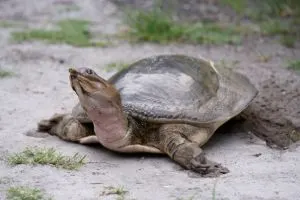
Quick Facts
- Family: Trionychidae
- Binomial Name: Apalone mutica
- Male Adult Size: 5 to 7 inches
- Female Adult Size: 7 to 14 inches
- Lifespan: 50 years
- Diet in the Wild: (primarily carnivorous) fish, mollusks, worms, millipedes, snails, vegetation, bark, seeds, fruits, algae, nuts, and bark
Quick Care Sheet
- Experience Level: Intermediate
- Tank Size: 75 to 100 gallons
- Water Temperature: 75 F
- Ambient Temperature: 80 to 85 F
- Basking Temperature: 85 to 90 F
- Captive Diet: Commercial Turtle Diet ex. Mazuri Aquatic Turtle Diet, fish, snails, worms
The smooth softshell turtle has a smooth shell carapace which feels soft and leathery. This makes the turtle easy to differentiate from the spiny softshell. In addition, the plastron is whitish with no distinguishing markings and no visible underlying bones.
This turtle is endemic to Kentucky and is considered a species of greatest conservation need under Kentucky’s Wildlife Action Plan.
2. Spiny Softshell
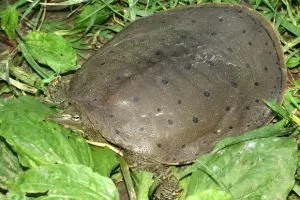
Quick Facts
- Family: Trionychidae
- Binomial Name: Apalone spinifera
- Adult Size: 5 to 19 inches
- Estimated Lifespan: 50 years
- Diet in the Wild: (primarily carnivorous) aquatic insects, terrestrial worms, crayfish, aquatic crustaceans, and fish.
Quick Care Sheet
- Experience Level: Intermediate
- Tank Size: 75 to 120 gallons, depending on size (large females may need a pond)
- Water Temperature: 75 F
- Ambient Temperature: 80 to 85 F
- Basking Temperature: 85 to 90 F
- Captive Diet: Commercial Turtle Diet ex. Mazuri Aquatic Turtle Diet, fish, snails, worms
The spiny softshell turtle can be found in most of continental North America and not just Kentucky.
The spiny softshell turtle is one of the two softshell turtles endemic to Kentucky. This turtle has a spiny carapace as evidential by the name. These spiny projections on the leading edge of the carapace.
This turtle has a brownish carapace with dark spots/blotches. While the males of the species are smaller, there isn’t much to differentiate between the two sexes.
In the wild, they can be found in rivers, streams, and lakes.
Snapping Turtles
There are two snapping turtles native to Kentucky. These are the common snapping turtle and the alligator snapping turtle.
3. Common Snapping Turtle
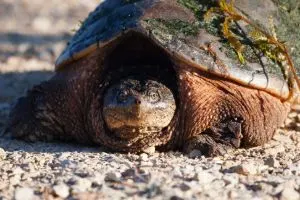
Quick Facts
- Family: Chelydridae
- Binomial Name: Chelydra serpentina
- Average Adult Size: 8 to 18 inches
- Estimated Lifespan: 47 years
- Diet in the Wild: fish, amphibians, small mammals, birds, eggs, amphibians, insects, mollusks, mollusks, and vegetation.
Quick Care Sheet
- Experience Level: Expert
- Tank Size: 120 to 300 gallons, depending on the size, they may need a pond
- Water Temperature: 75 F
- Ambient Temperature: 80 to 85 F
- Basking Temperature: 85 to 90 F
- Captive Diet: freshwater fish, snails, worms, lean meat
The common snapping turtle is a rugged-looking turtle with a rugged looking shell. They have a ridged carapace which is less pronounced the older they get.
They have a long tail that is almost as long as their body. The carapace of this turtle is dark brown to tan. Snapping turtles has tubercles on their limbs and necks.
The common snapping turtle is an aggressive turtle that can be tough to care for. As such, this isn’t a beginner’s level turtle. The common snapping turtle is really cold tolerant and has been seen swimming under frozen lakes.
4. Alligator Snapping Turtle
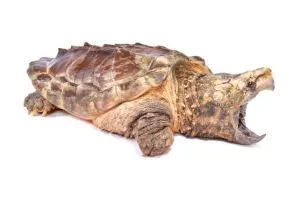
Quick Facts
- Family: Chelydridae
- Binomial Name: Macrochelys temminckii
- Average Adult Size: 15 to 26 inches
- Estimated Lifespan: 11 to 45 years
- Diet in the Wild: turtles, fish, amphibians, small mammals, birds, eggs, amphibians, small reptiles, insects, mollusks, mollusks, and grains, nuts, stems, bark, and vegetation.
Quick Care Sheet
- Experience Level: Expert
- Tank Size: 700 to 800 gallons
- Water Temperature: 75 to 80 F
- Ambient Temperature: 80 to 85 F
- Basking Temperature: 85 to 95 F
- Captive Diet: freshwater minnows, guppies, game fish, snails, worms, mice, lean meat such as cooked chicken,
The alligator snapping turtle looks very much like the common snapping turtle. They have a more rugged and rougher-looking shell and a bigger beak which is capable of amputating a human finger. The carapace has three rows of spikes which makes it resemble an alligator’s skin.
As a large turtle, a pond with dimensions of 20 ft diameter & 3 ft depth is an ideal habitat for this turtle. Both common snapping turtles and alligator snapping turtles are best kept alone as they can be very territorial and aggressive.
Mud and Musk Turtles
Mud turtle and musk turtle species found in Kentucky include the eastern mud turtle and the common musk turtle.
5. Eastern Mud Turtle
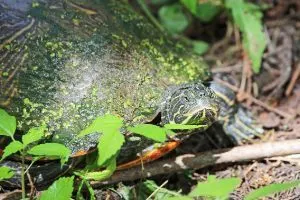
Quick Facts
- Family: Kinosternidae
- Binomial Name: Kinosternon subrubrum
- Average Adult Size: 3 to 4 inches
- Estimated Lifespan: Up to 20 years
- Diet in the Wild: small clams, amphibians, snails, crayfish, shrimp, fish, carrion, and vegetation
Quick Care Sheet
- Experience Level: Intermediate
- Tank Size: 40 gallons
- Water Temperature: 75 to 80 F
- Ambient Temperature: 74 and 81 F
- Basking Temperature: 90 to 95 F
- Captive Diet: Commercial diet ex. Zoo Med Natural Sinking Mud and Musk Turtle Food, shrimp, tilapia, feeder fish, and lean meat such as chicken, and raw lean beef
The Kinosternon subrubrum has a tan carapace with no keels or pattens. The plastron is also brownish to yellow. With a carapace length of just 3 to 4 inches, this chelonian is tiny.
The K. subrubrum is a small turtle that is quite easy to care for. Their small size makes them easy to accommodate. The K. subrubrum can be quite aggressive and can make them difficult to handle.
Only handle the mud turtle only when it’s necessary. The K. subrubrum doesn’t bask much and this is true of both captive and wild mud turtles.
6. Common Musk Turtle
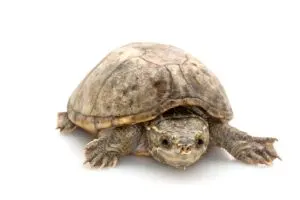
Quick Facts
- Family: Kinosternidae
- Binomial Name: Sternotherus odoratus
- Average Adult Size: 3 to 5 inches
- Estimated Lifespan: Up to 20 years
- Diet in the Wild: small fish, insects, mollusks, & carrion; they also eat small amounts of vegetation
Quick Care Sheet
- Experience Level: Intermediate
- Tank Size: 40 gallons
- Water Temperature: 75 to 80 F
- Ambient Temperature: 74 and 81 F
- Basking Temperature: 90 to 95 F
- Captive Diet: Commercial diet ex. Zoo Med Natural Sinking Mud and Musk Turtle Food, shrimp, tilapia, feeder fish, and lean meat such as chicken, and raw lean beef (they also accept insects)
The common musk turtle, also known as the stinkpot, is quite a small turtle with a highly domed blackish-brown carapace. On its head, there are two parallel yellow stripes.
Caring for this chelonian is relatively simple. As with mud turtles, musk turtles are also aggressive and really dislike being handled.
As with every other turtle, an individual stinkpot has a distinct personality. As such, your pet common musk turtle may not be as aggressive as the average.
Pond and Box Turtles
Emydidae is a family of turtles that contain both pond and box turtles found in the Americas.
Actually, box turtles are considered pond turtles although they aren’t aquatic. There are eight species of the family Emydidae. We will look at these.
7. Southern/Midland Painted Turtle
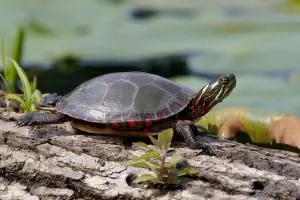
Quick Facts
- Family: Emydidae
- Binomial Name: Chrysemys picta
- Midland Painted Turtle Average Adult Size: 4 to 10 inches
- Southern Painted Turtle Average Adult Size: 4 to 6 inches
- Estimated Lifespan: 30 years
- Diet in the Wild: small fish, crustaceans, aquatic crustaceans, aquatic insects, and vegetation
Quick Care Sheet
- Experience Level: Beginner
- Tank Size: 40 gallons
- Water Temperature: 75 F
- Ambient Temperature: 81 F
- Basking Temperature: 85 to 95 F
- Captive Diet: insects such as crickets, bloodworms; and fish such as trout chow.
Both the midland (C. p. marginata) and the southern painted turtles (C. p. dorsalis) are subspecies of the painted turtles.
The midland painted turtle can be found from southern Quebec and Ontario all the way down to Alabama.
The southern painted turtle on the other hand is limited to the southern United States.
The carapace of the southern painted turtle has a red stripe on top and a tan spotless plastron. The midland painted turtle looks very much like the southern painted turtle but has a dark shadow in the center of its plastron.
8. Common Map Turtle
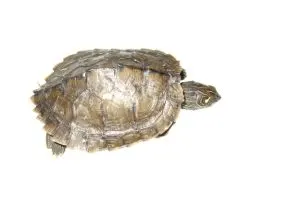
Quick Facts
- Family: Emydidae
- Binomial Name: Graptemys geographica
- Average Female Adult Size: 7 to 10.5 inches
- Average Male Adult Size: 3.5 to 6.5 inches
- Diet in the Wild: snails, insects, clams, snails, and crayfish, and vegetation
Quick Care Sheet
- Experience Level: Beginner
- Tank Size: 75 to 125 gallons for adults
- Water Temperature: 72 – 75 F for adults and subadults, 78 – 80 F for hatchlings and juveniles
- Ambient Temperature: 75 – 85 F
- Basking Temperature: 85 to 95 F
- Captive Diet: insects such as crickets, & earthworms; crayfish & ghost shrimp; aquatic plants & leafy greens.
The common map turtle, also known as the northern map turtle, is one of the more popular pond turtles found in the united states. If you decide to keep this turtle as a pet, they are easy to care for.
In the wild, however, the common map turtle can be found in large lakes and rivers in the north and in small rocky rivers and streams in the south.
The Graptemys geographica has a raised spikey keel and yellowish-orange markings on its shell. Their head, neck, and limbs also feature yellowish-orange stripes.
9. Ouachita Map Turtle
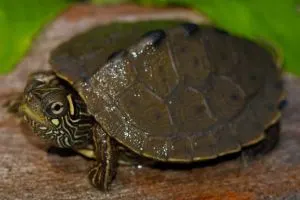
Quick Facts
- Family: Emydidae
- Binomial Name: Graptemys ouachitensis
- Average Adult Female Size: 5 to 10 inches
- Average Adult Male Size: 3½ to 5 inches
- Expected Lifespan: 15 to 20 years
- Diet in the Wild: snails, insects, clams, snails, and crayfish, and vegetation
Quick Care Sheet
- Experience Level: Beginner
- Tank Size: 75 to 125 gallons for adults
- Water Temperature: 72 – 75 F for adults and subadults, 78 – 80 F for hatchlings and juveniles
- Ambient Temperature: 75 – 85 F
- Basking Temperature: 85 to 95 F
- Captive Diet: insects such as crickets, & earthworms; crayfish & ghost shrimp; aquatic plants & leafy greens.
The Ouachita map turtle is another map turtle species found in Kentucky as well as across much of the southern united states. The Graptemys ouachitensis looks very much like your typical map turtle.
It has a sawback keel and contour patterns on its carapace. The carapace is dark in color with yellowish contour-like patterns.
Two subspecies make up the Graptemys ouachitensis and these incllude G. o. sabinensis and G. o. ouachitensis.
10. False Map Turtle
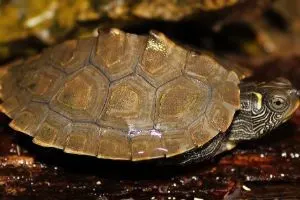
Quick Facts
- Family: Emydidae
- Binomial Name: Graptemys pseudogeographica
- Average Adult Size: 3½ to 10.5 inches
- Expected Lifespan: 32.5 years
- Diet in the Wild: snails, insects (such as beetles, flies, insect larvae), clams, snails, and crayfish, and vegetation
Quick Care Sheet
- Experience Level: Beginner
- Tank Size: 55 to 100 gallons
- Water Temperature: 75 F
- Air Temperature: 80 – 85 F
- Basking Temperature: 85 to 90 F
- Captive Diet: insects such as crickets, & earthworms; crayfish & ghost shrimp; aquatic plants & leafy greens; and commercial diet
The false map turtle species includes the Mississippi map turtle (G. p. kohnii) and, of course, the nominotypical subspecies is the false map turtle (G. p. pseudogeographica).
In the wild, the meal of the Graptemys pseudogeographica depends on the size. Since males are much smaller than females, they eat smaller animals such as smaller fish, and insects.
In general, the Graptemys pseudogeographica is a gentle reptile and hardly ever bite when handled. This makes them excellent beginner pets, especially for children.
As these turtles can live to35 years of age, you need to carefully deliberate before you adopt or buy one.
11. Eastern River Cooter
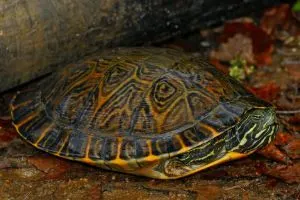
Quick Facts
- Family: Emydidae
- Scientific Name: Pseudemys concinna concinna
- Average Adult Female Size:11 inches
- Average Adult Male Size: 9 inches
- Expected Lifespan: 20 years
- Diet in the Wild: crayfish & non-insect arthropods; algae, macroalgae, eelgrass, and other aquatic vegetation
Quick Care Sheet
- Experience Level: Intermediate
- Tank Size: 300 gallons
- Water Temperature: 75 F
- Air Temperature: 80 F
- Basking Temperature: 85 F
- Captive Diet: insects such as crickets, & earthworms; crayfish; aquatic plants & leafy greens; and commercial diet
The eastern river cooter is a large turtle. It can grow up to 16.5 inches. If you plan on keeping this turtle, you’d eventually need a huge tank such as a cattle watering tank or an outdoor pond.
In the wild, this chelonian is usually found in permanent water bodies and rarely in ponds, springs, and other temporary water bodies.
As with many other aquatic turtles found in Kentucky, this cooter spends a large portion of its day basking.
This cooter has a tan greenish carapace and a ‘C’ mark that faces the posterior. The plastron is reddish to yellow in color with dark markings between the scutes.
12. Red-eared Slider
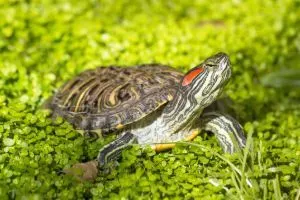
Quick Facts
- Family: Emydidae
- Scientific Name: Trachemys scripta elegans
- Average Adult Size: 6 to 8 inches
- Expected Lifespan: 20 to 40 years
- Diet in the Wild: fish, eggs, carrion, reptiles, crustaceans, mollusks & terrestrial non-insect arthropods; algae, grains & nuts, seeds, & other aquatic vegetation
Quick Care Sheet
- Experience Level: Beginners
- Tank Size: 75 gallons
- Water Temperature: 75 F
- Air Temperature: 80 F
- Basking Temperature: 85 to 95 °F
- Captive Diet: insects such as crickets, & earthworms; crayfish, krill & shrimp; aquatic plants & leafy greens; and commercial turtle diet
The red-eared sliders are among the most common turtles kept as pets. This is because this slider is easy to care for and are hardy.
This turtle is endemic to the Southern United States which includes Kentucky. The species is known as invasive species as they can thrive in a wide range of ecosystems.
The red-eared slider is easily identifiable by the red streaks on their ears.
13. Eastern box turtle
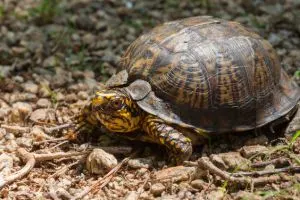
Quick Facts
- Family: Emydidae
- Scientific Name: Terrapene carolina carolina
- Average Adult Size: 4 to 7 inches
- Expected Lifespan: 40 years
- Diet in the Wild: caterpillars, beetles, grubs, slugs, snails, earthworms; grasses, mushrooms, flowers, fruits, berries, and other plant matter
Quick Care Sheet
- Experience Level: Beginners
- Tank Size: 20 – 75 gallons
- Air Temperature: 80 F
- Basking Temperature: 85 to 95 °F
- Captive Diet: insects such as crickets, & mealworm; crayfish, krill & shrimp; leafy greens, fruits and other vegetables; and commercial turtle diet
The Eastern box turtles may look like tortoise because of its high dome and terrestrial nature but it isn’t considered a tortoise species. In fact, this turtle is technically a pond turtle.
As a terrestrial turtle, the Terrapene carolina carolina can be found in woodlands, pastures, and even meadows. They usually live near ponds and streams.
This chelonian has a highly domed carapace and hinged plastron. Their coloration varies from one individual to another but generally, their carapace is brown or black with yellowish-orange markings.
Similarly, their head, neck, and limbs are also brownish with yellowish-orange spots and streaks.
Conclusion
Kentucky is home to many reptiles which includes several turtles. Among these many turtles, a few are considered ‘species of greatest conservation need’.
These include alligator snapping turtle, eastern mud turtle, false map turtle, Mississippi map turtle, and southern painted turtle. If you come across a wild turtle, it is best to leave it alone regardless of its conservation status.
Collecting wild turtles can adversely affect the wild population. In addition to this, wild turtles generally carry salmonella.
Some Kentucky turtles such as snapping turtles are quite aggressive when approached and can seriously injure you.
However, if you wish to help a turtle across a road do so with care so it doesn’t bite you.
If you have any questions or information to share, kindly leave a comment.
Other nearby states
- Turtles in Illinois
- Turtles in Indiana
- Turtles in Ohio
- Turtles in Missouri
- Turtles in Tennessee
- Turtles in Virginia
- Turtles in West Virginia
